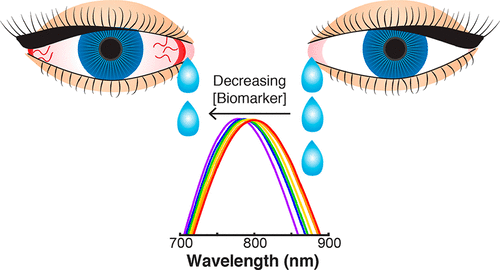Our official English website, www.x-mol.net, welcomes your
feedback! (Note: you will need to create a separate account there.)
Label-Free Detection of Tear Biomarkers Using Hydrogel-Coated Gold Nanoshells in a Localized Surface Plasmon Resonance-Based Biosensor
ACS Nano ( IF 15.8 ) Pub Date : 2018-09-11 00:00:00 , DOI: 10.1021/acsnano.8b04348 Heidi R. Culver , Marissa E. Wechsler , Nicholas A. Peppas
ACS Nano ( IF 15.8 ) Pub Date : 2018-09-11 00:00:00 , DOI: 10.1021/acsnano.8b04348 Heidi R. Culver , Marissa E. Wechsler , Nicholas A. Peppas

|
The dependence of the localized surface plasmon resonance (LSPR) of noble-metal nanomaterials on refractive index makes LSPR a useful, label-free signal transduction strategy for biosensing. In particular, by decorating gold nanomaterials with molecular recognition agents, analytes of interest can be trapped near the surface, resulting in an increased refractive index surrounding the nanomaterial, and, consequently, a red shift in the LSPR wavelength. Ionic poly(N-isopropylacrylamide-co-methacrylic acid) (PNM) hydrogels were used as protein receptors because PNM nanogels exhibit a large increase in refractive index upon protein binding. Specifically, PNM hydrogels were synthesized on the surface of silica gold nanoshells (AuNSs). This composite material ([email protected]) was used to detect changes in the concentration of two protein biomarkers of chronic dry eye: lysozyme and lactoferrin. Both of these proteins have high isoelectric points, resulting in electrostatic attraction between the negatively charged PNM hydrogels and positively charged proteins. Upon binding lysozyme or lactoferrin, [email protected] exhibits large, concentration-dependent red shifts in LSPR wavelength, which enabled the detection of clinically relevant concentration changes of both biomarkers in human tears. The LSPR-based biosensor described herein has potential utility as an affordable screening tool for chronic dry eye and associated conditions.
中文翻译:

在基于局部表面等离子共振的生物传感器中使用水凝胶涂层的金纳米壳对泪液生物标志物进行无标记检测
贵金属纳米材料的局域表面等离子体共振 (LSPR) 对折射率的依赖性使 LSPR 成为一种有用的、无标记的生物传感信号转导策略。特别是,通过用分子识别剂修饰金纳米材料,可以将感兴趣的分析物捕获在表面附近,从而导致纳米材料周围的折射率增加,从而导致局域表面等离子体共振波长红移。离子聚(N-异丙基丙烯酰胺-甲基丙烯酸)(PNM)水凝胶被用作蛋白质受体,因为PNM纳米凝胶在蛋白质结合后表现出折射率的大幅增加。具体来说,PNM 水凝胶是在硅金纳米壳 (AuNSs) 表面合成的。这种复合材料([email protected])用于检测慢性干眼病的两种蛋白质生物标志物浓度的变化:溶菌酶和乳铁蛋白。这两种蛋白质都具有高等电点,导致带负电的 PNM 水凝胶和带正电的蛋白质之间产生静电吸引力。与溶菌酶或乳铁蛋白结合后,[email protected] 在 LSPR 波长中表现出较大的浓度依赖性红移,这使得能够检测人类泪液中两种生物标志物的临床相关浓度变化。本文描述的基于 LSPR 的生物传感器具有作为慢性干眼及相关病症的负担得起的筛查工具的潜在用途。
更新日期:2018-09-11
中文翻译:

在基于局部表面等离子共振的生物传感器中使用水凝胶涂层的金纳米壳对泪液生物标志物进行无标记检测
贵金属纳米材料的局域表面等离子体共振 (LSPR) 对折射率的依赖性使 LSPR 成为一种有用的、无标记的生物传感信号转导策略。特别是,通过用分子识别剂修饰金纳米材料,可以将感兴趣的分析物捕获在表面附近,从而导致纳米材料周围的折射率增加,从而导致局域表面等离子体共振波长红移。离子聚(N-异丙基丙烯酰胺-甲基丙烯酸)(PNM)水凝胶被用作蛋白质受体,因为PNM纳米凝胶在蛋白质结合后表现出折射率的大幅增加。具体来说,PNM 水凝胶是在硅金纳米壳 (AuNSs) 表面合成的。这种复合材料([email protected])用于检测慢性干眼病的两种蛋白质生物标志物浓度的变化:溶菌酶和乳铁蛋白。这两种蛋白质都具有高等电点,导致带负电的 PNM 水凝胶和带正电的蛋白质之间产生静电吸引力。与溶菌酶或乳铁蛋白结合后,[email protected] 在 LSPR 波长中表现出较大的浓度依赖性红移,这使得能够检测人类泪液中两种生物标志物的临床相关浓度变化。本文描述的基于 LSPR 的生物传感器具有作为慢性干眼及相关病症的负担得起的筛查工具的潜在用途。







































 京公网安备 11010802027423号
京公网安备 11010802027423号